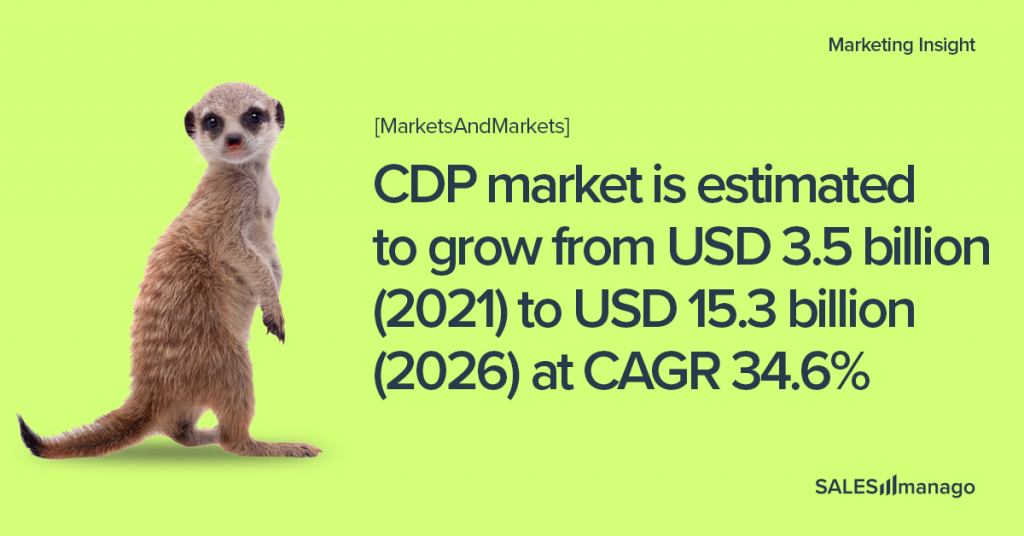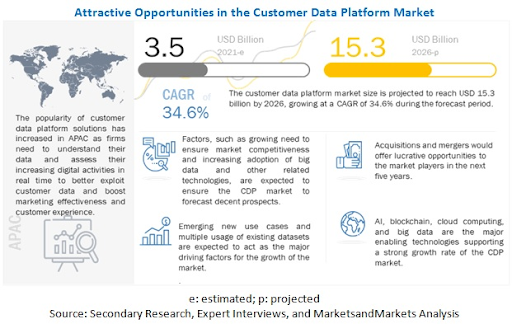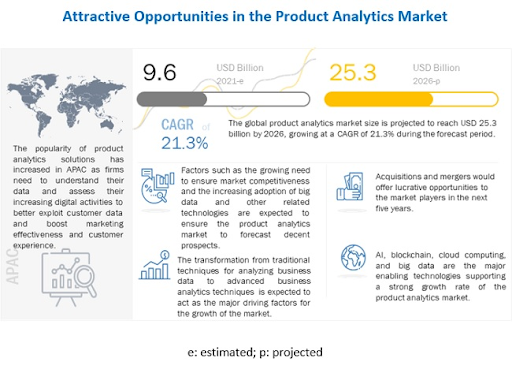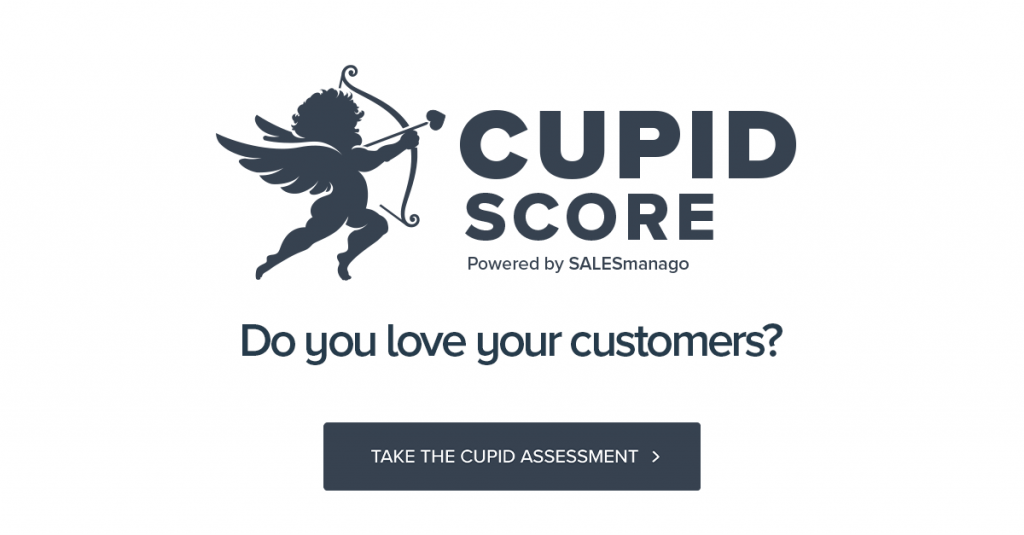
As the company matures, its MarTech stack grows more or less complete and it leaves less room for new tools and improvements, not to mention the costs, that grow rapidly. Yet, the CDP market growth estimations show some whooping values, and this fact clearly indicates that even mature companies see the potential in enriching the stack with Customer Platform. This happens, because CDP not only integrates seamlessly with the existing MarTech stack without major changes or costs, but unlocks the potential of this stack in the first place, making money invested in the MarTech in the past pay off more. In this article we will explain, in detail, how.
CDPs and CIPs rapid rise and the question why?
It is estimated that the customer data platform market will grow from USD 3.5 billion in 2021 to USD 15.3 billion by 2026, at CAGR 34.6%.

During the same forecast period, the global analytics market size is estimated to grow from USD 9.6 billion in 2021 to USD 25.3 billion by 2026, at CAGR 21.3%.

TheNext Gen CDPs or AI-empowered, Customer Intelligence Platforms, which are basically the same, fall simultaneously into these two categories. On top of this, 84% of marketers plan to include AI capabilities in-house. AI plays an essential role in a modern CDP.
Companies around the world adopt CDPs into their MarTech stack, and they do it rather rapidly, like it would be a must-have for a company to even keep up with the competition.
But why?
As we will show in the next chapter, the current MarTech stack, modeled on an average, mature eCommerce company, is already rather impressive. Various expensive systems already are supposed to work in synergy, to provide the companies with outstanding customer insights and assure unparalleled customer experience throughout all the touchpoints.
The truth is, that they don’t. Or actually didn’t, until Next Gen CDPs / CIPs entered the stage. Each of the tools in the model stack works well, does what it was designed to do. It is their orchestration that proves to be lacking.
In this article we will uncover the reason behind the rapid CDPs market growth, by explaining, how the adoption of a CDP not only adds it’s individual value, but, finally, unlocks all the repressed potential of all the tools already in disposition, enabling true synergy and becoming functional foundation of the modern MarTech stack.
First let’s take a look at a model stack, often in use today.
Traditional MarTech stack model
There are plenty of tools in a typical MarTech stack. In this chapter we will briefly introduce some of them and explain how they are supposed to work together to collect the customer data and then activate it in various channels/touchpoints.
Data collection
Enterprise Tag Management
Tag management systems control the deployment of all other tags and mobile vendor deployments via web interface, without any software coding. Tag management systems make it easy to add, edit or remove any tag with point and click simplicity.
- manages data collection
- manages third-party tags
- manges digital data distribution
Digital Analytics
Digital analytics tools gather and analyze digital data from various sources like websites, mobile applications, among others. It provides a vision on how users or customers are behaving. Through digital analytics, companies obtain an insight into the areas where they need improvement.
- behavior and segmentation
- analytics
- historical segmentation
Data Management Platform (DMP)
A direct predecessor to CDP platforms, that was “almost it”, emerged in the early 2000’s. DMP gathers and organizes second and third-party data and shares it with other marketing technology systems to gain deeper insights into customers. It can also segment anonymous ID’s.
- customer recognition
- audience segmentation, activation and orchestration
- look alike modeling and third-party data
CRM
As of 2021, we can easily call Customer Relation Management the legacy system. It came into existence even before DMPs, in the early 1990’s. It is a technology for managing a company’s relationships and interactions with all of its customers and potential customers. It started with sales, then customer service and marketing came along. Finally commerce joined. Primarily however, CRM works with operational data of known customers.
- customer data, scoring and attributes
- opt-in preferences
- products/orders
Data Activation
CMS and eCommerce tools
- DAM and Content Management
- Template creation and publication
- Content authoring
On-site and app personalization tools
- A/B and MV testing
- Targeting and personalization
- Recommendation
Media tools
- DSP/Ad Server
- Retargeting platforms
- SEM tools
- Paid social platforms
Cross-channel Campaign Mgtm.
- Direct Marketing automation management
- Contact and Offers management
How they all are supposed to work together
This classic package of tools is fundamental to lay a baseline for digital data collection and activation.
In the collection part, data from the Tag Management tool is sent for analysis and segmentation to the Digital Analytic tool. Such prepared data is then sent to DMP, that should provide customer recognition, segmentation and orchestration, using third-party data. DMP also exchanges the data with the legacy CRM, enriching it and taking what is needed for recognition and segmentation. From this central, DMP part, data is then activated.
The data is transferred to various activation systems: CMS and eCommerce, On-site and app personalization tools are used to manage the content of the websites and apps as well as for testing, targeting, and personalization of this content. Media tools optimize the content for paid external media, and Cross-channel Campaign Mgtm. has the use in Direct Marketing, like email, sms or chat channels.
In reality, such a stack does not work smoothly enough to feed the activation tools with real-time, unified data.
Traditional MarTech stack painpoints
Dispersed data
Systems like DMP and CRM keep the data in their own silos. They are connected, they are able to mutually enrich or correct their datasets, but none of them puts them all together to create a unified, single source of truth about the customer.
From this problem another emerges. Traditional MarTech stack suffers from connection issues between different tools and technologies. The difference in implementation of these tools results in loss of data consistency across the stack.
Security and privacy issues
When there is inconsistency and connection issues, the often invaluable data gets inevitably lost. Traditional MarTech stack puts the companies at a major risk of either have their customer data stolen by the outside agent, or misused by i.eg. marketing team.
It is next to impossible to control and protect from the hackers all the data flowing back and forth between different systems and technologies, when each has its technological weak spots and it is hard to determine if a data loss, leak or change was an effect of connection problems, human error or outside intrusion. It is no less difficult to manage the customer marketing consents in this situation.
Identity resolution
Another problem, linked to data consistency and time to activation, is insufficient ability of the traditional MarTech stack to solve identity resolution. Without a single source of truth about the consumer for the company, marketers are forced to use third-party data in their efforts to unify the customer profile. Third-party data are, as for 2021, becoming a thing of the past. Not to mention, how much time and effort has to be put into, in the end, futile trying to achieve a unified customer profile.
Time to activation and time to market
Marketing teams and, actually all teams in a company, struggle to deliver the effect of their efforts to the market on time. They are forced to manage the data using too many systems and tools that capture different datasets.
Unfulfilled potential of the MarTech tools
All these problems combined diminish and repress the potential that each of the tools in the stack has. Fed with inconsistent data, transferred across differently implemented systems, the tools work slow and fail to produce really usable results. And delivering them in real-time is out of the question.
To put it simply, traditional MarTech Stack fails in the task of providing consistent, connected and actionable customer experience in all touchpoints offline and online.
CDP / CIP definition
The Customer Data Platforms emerged to deal with this problem exactly. Before we explain how the CDPs work, let’s define them. They were designed not to displace all the expensive MarTech stack, but to finally unlock it’s potential and make the data gathered in it usable.
The most clear and understandable definition of a Customer Data Platform is probably this on, provided by Gartner: “A customer data platform is a marketing system that unifies a company’s customer data from marketing and other channels to enable customer modeling, and optimize the timing and targeting of messages and offers.”.
Another, also interesting, has been coined by the CDP Institute. According to them, the Customer Data Platform is a “packaged software that creates a persistent, unified customer database that is accessible to other systems.”.
“Packaged software” means that CDP is ready-to-use, off-the-shelf software, provided usually by the vendor.
The part about “persistent, unified customer database” means that CDP collects the data from many different sources, basically, all the company’s touchpoints, where acquiring first-party consumer data is possible, like sales, loyalty, customer service, social media, etc. Data from different sources is stored in CDP, then merged and unified into a single customer profile.
Finally, “accessible to other systems” means that customer data is shared with any other system that needs it, like those used by sales, marketing, commerce.
Customer Intelligence Platform (CIP) is the next step in CDPs evolution. CIPs include zero-party data along with first-party data to provide insights. And they leverage AI and machine learning to understand, resolve and evaluate both structured and unstructured data available to the company.
CDP / CIP is just one system, collecting and analyzing data from all other tools/systems/touchpoints simultaneously, and building a unified customer profile, providing a single source of truth for the whole company in real-time.
Four CDP steps in making data consistent and usable
The CDP actually provides consistent, connected and actionable customer experience in all touchpoints offline and online. Unlike in the case of traditional MarTech stack, without CDP, where data is integrated in every tool separately, Customer Data Platform simply does it all, utilizing the whole stack and touchpoints, physical and digital.
Collecting data from omnichannel sources
The first task for CDP is to collect data from all channels, physical, like stores or call centres, and digital. The data originating from these omnichannel is sometimes anonymous, sometimes nominative. For example when they are linked to an email account or loyalty number.
This data, gathered in real time, is then linked to a wide range of attributes: promotional campaign, content consumed, purchase history, and stored. The goal is to gather all the precious first-party data to help develop customer intelligence.
- personal and demographic data
- onsite bahavioural data
- engagement data
- transactiona data
- mobile data
Matching data to the same individual
Traditional marketing primarily targets devices. Today’s approach builds the contact around the person, the individual customer for better relevance.The next step CDP does is matching collected data for a people-based approach.
Cross-channel and cross-device matching is a painful task. First-party and zero-party data can prove useful in helping link information originating from different channels and devices to one single person. CDP also makes use of the existing stack, as the CRM, to extract old and nominative information that it can employ to successfully build a unified customer profile. It can also take data from CRM and send it back enriched from other sources.
- preparation
- integration
- enrichment
Segmentation and activation
Personal relationships with the consumer is a fundamental goal for modern marketers. To provide the means to do this, CDPs have the ability to precisely segment profiles. This is its third step.
The CDPs task is to increase the number of possible segments based on several criteria: demography, geography, behaviour, etc. The CDP will then use these audience segments as a foundation to activate the solutions available, i. e.g. Dynamic Creative Optimization or personalised advertisements, marketing automation sequences or website personalisation.
The CDP can also activate data in physical touchpoints such as stores and call centres.
- defining rules
- building the audience
- real time
- push messaging
- sms
- social
- web
Analyzing and optimizing
In the third step activations are applied to segments and the subsequent results are analysed and serve as feedback to further refine these segments and activations. For example CDP gets the best out of A/B testing solutions. CDP can be connected to DMP to provide segments obtained from advanced statistics module as predicted ones.
The CDP breaks down metric silos and minimises interpretation bias for campaign results. In the case of the traditional MarTech stack, the attribution models are still rather basic. The ways in which the performance of i.e.g. campaigns are too isolated to provide the company with sufficient, unbiased results. CDP’s central coordinator role allows for distinct performance metrics from one scenario to another.
- modeling
- analysing
- automation
CDP fit into marketing stack
Since CDP effectively utilizes all existing MarTech stack employed by the company, one can ask, what this platform really is and how it fits into the existing stack? Is it just another solitary, monolith solution? A system built from several services? Or maybe an architecture, putting together and squeezing the most of already existing tools?
Since the answer to all above questions may easily sound “yes” it is clear that CDP means for the company more than just its definition.
The most practical role or a function for CDP in a MarTech stack is to be its foundation, making all the data gathered in there a single truth, actionable for all the company’s divisions. It does not change the precious stack itself, instead acts as a support for each and every individual tool and adds a value to it.
Challenges for CDPs in the future
As for 2021, the biggest challenge for CDP’s, both platform providers and their clients, is an accurate assessment of how much data is actually enough.
Everybody knows that more data provides the analyses with more context and provides the company with more meaningful results. But the major obstacles for unobscured customer data landscape can be summed up in these questions:
- How can deeper insight into customers’ patterns be gained?
- How to store all this data?
- How to do it safely?
- How much of it is actually useful in terms of enhancing customer experience?
Currently, we work to address all these issues, in order to provide our clients with even more useful datasets that will be actionable across all the company’s touchpoints on the customer journey.
To see what immense possibilities in providing consistent, connected and actionable data a modern CDP can offer you today, request a SALESmanago demo.

 Follow
Follow
















